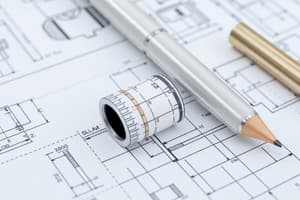Podcast
Questions and Answers
Which of the following is NOT a primary purpose of technical standards in engineering drawings?
Which of the following is NOT a primary purpose of technical standards in engineering drawings?
- To define terms and symbols, particularly those specific to a company
- To establish rules and guidance for engineering and drafting
- To ensure the seamless integration of various engineering software programs (correct)
- To provide a glossary of abbreviations and acronyms
Which of the following benefits does the use of abbreviations in engineering drawings offer?
Which of the following benefits does the use of abbreviations in engineering drawings offer?
- Increased ambiguity and room for interpretation
- Decreased manufacturing costs
- Elimination of the need for detailed schematics and diagrams
- Enhanced communication and collaboration among engineers (correct)
What is the primary purpose of using a part number/code?
What is the primary purpose of using a part number/code?
- To identify the specific material used in the component.
- To classify the component based on its electrical properties.
- To provide a unique ID for assembly drawings.
- To ensure standardization across engineering industries. (correct)
What is the significance of the 'Component Name' in a part specification?
What is the significance of the 'Component Name' in a part specification?
What is the primary function of a Drawing Standards Manual?
What is the primary function of a Drawing Standards Manual?
What is the primary purpose of circuit notation and reference designators?
What is the primary purpose of circuit notation and reference designators?
What is the purpose of having a 'Material Specification' in a part specification?
What is the purpose of having a 'Material Specification' in a part specification?
Which of the following is NOT a key aspect of the standards definition?
Which of the following is NOT a key aspect of the standards definition?
What is the main purpose of a System, Payload, or Component Assembly Definition?
What is the main purpose of a System, Payload, or Component Assembly Definition?
What does a circuit reference designator typically consist of?
What does a circuit reference designator typically consist of?
Which of the following is NOT a standard system for electronic symbols?
Which of the following is NOT a standard system for electronic symbols?
What are some alternative names for a circuit diagram?
What are some alternative names for a circuit diagram?
Which of the following is a common misconception about the importance of design designations in engineering drawings?
Which of the following is a common misconception about the importance of design designations in engineering drawings?
Which of the following is a benefit of using standardized electronic symbol systems?
Which of the following is a benefit of using standardized electronic symbol systems?
Which standard is currently used for electrical/electronics parts identification?
Which standard is currently used for electrical/electronics parts identification?
Which of the following is NOT a primary area of application for engineering drawing abbreviations?
Which of the following is NOT a primary area of application for engineering drawing abbreviations?
What is the primary distinction between the IEC 60617 and ANSI Y32 (IEEE Std 315) standard systems?
What is the primary distinction between the IEC 60617 and ANSI Y32 (IEEE Std 315) standard systems?
What is the main purpose of using standardized representations for circuit elements?
What is the main purpose of using standardized representations for circuit elements?
In the Australian Standard AS 1102, where are pin numbers typically located on a symbol?
In the Australian Standard AS 1102, where are pin numbers typically located on a symbol?
What is the fundamental goal of establishing a standardized system for engineering drawings and documentation?
What is the fundamental goal of establishing a standardized system for engineering drawings and documentation?
Where is the Title Block typically placed on the first sheet of engineering drawings?
Where is the Title Block typically placed on the first sheet of engineering drawings?
What kind of information is typically presented in a 'History' page for a circuit?
What kind of information is typically presented in a 'History' page for a circuit?
What is the main purpose of including a block diagram in circuit documentation?
What is the main purpose of including a block diagram in circuit documentation?
What is the primary benefit of using good schematic drawing practices?
What is the primary benefit of using good schematic drawing practices?
What design principle should be prioritized when creating a circuit diagram?
What design principle should be prioritized when creating a circuit diagram?
Why is it important to use straight lines when drawing wires in a circuit diagram?
Why is it important to use straight lines when drawing wires in a circuit diagram?
What is the main purpose of net naming in circuit diagrams?
What is the main purpose of net naming in circuit diagrams?
Which of the following is NOT a recommended practice for component placement in a circuit diagram?
Which of the following is NOT a recommended practice for component placement in a circuit diagram?
Which of these is NOT a typical method for creating connections in a circuit?
Which of these is NOT a typical method for creating connections in a circuit?
What is the main advantage of using a circuit diagram before building a circuit?
What is the main advantage of using a circuit diagram before building a circuit?
Which type of connection method is best suited for temporary or easily replaceable connections?
Which type of connection method is best suited for temporary or easily replaceable connections?
What information should be included in a basic wiring diagram label?
What information should be included in a basic wiring diagram label?
Which diagram type is most suitable for complex circuits with numerous components, where actual wire routing may be less important than the connections themselves?
Which diagram type is most suitable for complex circuits with numerous components, where actual wire routing may be less important than the connections themselves?
What is the significance of the '0V Label' in a wiring diagram?
What is the significance of the '0V Label' in a wiring diagram?
Which of the following is NOT a characteristic of a Component Representation diagram?
Which of the following is NOT a characteristic of a Component Representation diagram?
Which of the following is a benefit of using a Continuous Line Diagram?
Which of the following is a benefit of using a Continuous Line Diagram?
In a wiring diagram, what is the function of polarity markings (like '+' and '-') on components?
In a wiring diagram, what is the function of polarity markings (like '+' and '-') on components?
Why are wires often color-coded in wiring diagrams?
Why are wires often color-coded in wiring diagrams?
What is the primary difference between 'Science' and 'Electronics' contexts in drawing wiring diagrams?
What is the primary difference between 'Science' and 'Electronics' contexts in drawing wiring diagrams?
Which of these is NOT a standard characteristic of a wire used in electrical and electronic circuits?
Which of these is NOT a standard characteristic of a wire used in electrical and electronic circuits?
What is the primary purpose of insulation in a wiring diagram?
What is the primary purpose of insulation in a wiring diagram?
What is the main difference between a point-to-point wiring diagram and a trunkline or highway diagram?
What is the main difference between a point-to-point wiring diagram and a trunkline or highway diagram?
Which of the following is NOT a method of managing heat in electronic circuits?
Which of the following is NOT a method of managing heat in electronic circuits?
What is the primary benefit of using signal distribution techniques in wiring diagrams?
What is the primary benefit of using signal distribution techniques in wiring diagrams?
What is the purpose of power distribution in a wiring diagram?
What is the purpose of power distribution in a wiring diagram?
Which of the following is a characteristic of baseline or airline wiring diagrams?
Which of the following is a characteristic of baseline or airline wiring diagrams?
Which of these wiring diagram types allows for the most detailed visualization of individual wires?
Which of these wiring diagram types allows for the most detailed visualization of individual wires?
Why is it important to clearly identify each wire in a wiring diagram?
Why is it important to clearly identify each wire in a wiring diagram?
Flashcards
Engineering Drawing Abbreviations
Engineering Drawing Abbreviations
Symbols and short forms used to detail characteristics in engineering drawings.
Technical Standards
Technical Standards
Established criteria for normalizing engineering drawing processes and definitions.
Drawing Standards Manual
Drawing Standards Manual
A document that sets conventions, rules, and templates for engineering drawings.
System Assembly Definition
System Assembly Definition
Signup and view all the flashcards
Designations
Designations
Signup and view all the flashcards
Purpose of Abbreviations
Purpose of Abbreviations
Signup and view all the flashcards
Quality in Standards
Quality in Standards
Signup and view all the flashcards
Interoperability
Interoperability
Signup and view all the flashcards
Part Number/Code
Part Number/Code
Signup and view all the flashcards
Component Name
Component Name
Signup and view all the flashcards
Material Specification
Material Specification
Signup and view all the flashcards
Drawing Number
Drawing Number
Signup and view all the flashcards
IEC 60617
IEC 60617
Signup and view all the flashcards
ANSI Y32
ANSI Y32
Signup and view all the flashcards
Pin Numbers
Pin Numbers
Signup and view all the flashcards
Title Block Placement
Title Block Placement
Signup and view all the flashcards
Circuit Notation
Circuit Notation
Signup and view all the flashcards
Circuit Reference Designator
Circuit Reference Designator
Signup and view all the flashcards
Bill of Materials (BOM)
Bill of Materials (BOM)
Signup and view all the flashcards
Circuit Diagram
Circuit Diagram
Signup and view all the flashcards
Standardization
Standardization
Signup and view all the flashcards
Electrical/Electronic Diagram
Electrical/Electronic Diagram
Signup and view all the flashcards
Components & Symbols
Components & Symbols
Signup and view all the flashcards
Interconnections
Interconnections
Signup and view all the flashcards
Electrical Connections
Electrical Connections
Signup and view all the flashcards
Node in Intersecting Lines
Node in Intersecting Lines
Signup and view all the flashcards
Net Naming
Net Naming
Signup and view all the flashcards
Text & Orientation
Text & Orientation
Signup and view all the flashcards
Schematic Organization
Schematic Organization
Signup and view all the flashcards
Correct Symbol Usage
Correct Symbol Usage
Signup and view all the flashcards
Wire Layout
Wire Layout
Signup and view all the flashcards
Component Labeling
Component Labeling
Signup and view all the flashcards
Insulation Purpose
Insulation Purpose
Signup and view all the flashcards
Point to Point Wiring
Point to Point Wiring
Signup and view all the flashcards
Trunkline Wiring
Trunkline Wiring
Signup and view all the flashcards
Signal Distribution
Signal Distribution
Signup and view all the flashcards
Power Distribution
Power Distribution
Signup and view all the flashcards
Baseline Wiring
Baseline Wiring
Signup and view all the flashcards
Termination Method
Termination Method
Signup and view all the flashcards
Thermal Management
Thermal Management
Signup and view all the flashcards
0V Label
0V Label
Signup and view all the flashcards
Continuous Line Diagram
Continuous Line Diagram
Signup and view all the flashcards
Interrupted Line Diagram
Interrupted Line Diagram
Signup and view all the flashcards
Wire Types
Wire Types
Signup and view all the flashcards
Wire Insulation
Wire Insulation
Signup and view all the flashcards
Wiring Diagram
Wiring Diagram
Signup and view all the flashcards
Size/Gauge of Wire
Size/Gauge of Wire
Signup and view all the flashcards
Tabular Form Diagram
Tabular Form Diagram
Signup and view all the flashcards
Study Notes
Importance of Designations, Standards, and Abbreviations
- Engineering drawing abbreviations and symbols communicate and detail characteristics of drawings used in manufacturing and inspection.
- Technical standards provide glossaries of abbreviations, acronyms, and symbols.
- Drawing standards manuals establish conventions for engineering and drafting.
- These manuals set minimum requirements for drawings, ensuring standardization and uniform interpretation.
- System, Payload, or Component Assembly Definitions designate a unique identifier or reference for parts, components, or features.
- This includes a part number/code (alphanumeric), component name, material specifications, and drawing number.
Standards
- Standards develop, promote, and mandate compatible technologies and processes.
- Focus areas include quality, consistency, compatibility, interoperability, and safety.
- Standards normalize processes and technology.
- They establish rules, guidelines, and templates to ensure conformity and quality across activities.
- Abbreviations are standardized symbols, used in mechanical, electrical, piping, plumbing and civil/structural engineering drawings.
- Abbreviations save time, improve accuracy, clarify information, simplify complex information, and reduce costs. They ensure standardization across engineering industries.
Electronic Symbol System
- Different standards exist, like IEC 60617, and ANSI Y32/IEEE Std 315.
- These standards are used for creating circuit symbols, and ensure international compatibility.
Circuit Notation and Reference Designators
- Identifies components in circuit diagrams and schematics
- Cross-references with parts lists or Bills of Materials (BOMs)
- Aids in repair and troubleshooting of printed circuit boards
- Format uses letters and numbers (example R13, C45)
- Letters indicate component type. Numbers identify specific components.
- IEEE 200-1975 and ASME Y14.44-2008 are key standards for reference designations.
Circuit Layout/Design
- Circuit diagrams graphically represent electrical and electronic circuits; they simplify the circuit structure.
- Graphical representations of circuit elements (components and their connections) are standardized symbols.
- Electrical/Electronic diagrams are alternative names for a circuit diagram.
- Elementary diagrams are basic representations of circuit components.
- Electronic Schematics are tools used for circuit design.
- Designers use the diagrams to understand connections, not necessarily the physical positions of components.
- Design, construction, and maintenance are purposes of circuit diagrams used by electricians/engineers/technicians.
Drawing Circuit Diagram Tips
- Use accurate symbols for components.
- Draw lines neatly using straight lines (preferably with a ruler).
- Mark junctions with a 'blob'.
- Label components with their respective values.
- Label positive (+) and negative (-) terminals of the power supply.
- Use appropriate labels, specifications, and symbols.
Wiring and Cabling Diagram
- Wiring diagrams show physical relationships between electrical/electronic components, including connections.
- Diagrams use lines to represent connections.
- Types include continuous and interrupted lines connecting components
- Diagrams include labels for wire size/type, insulation type/color, and connection methods.
Electronic Packaging
- Electronic packaging protects electronic/electrical components from the environment and vice versa.
- This involves housing and interconnection of integrated circuits.
- Packaging protects equipment from electrostatic discharge, harmful environmental conditions, and heat.
- Various levels exist in electronic packaging, from "chip" to entire systems.
- Materials used in packaging include polymers, glasses, and various metals.
Standards (IPC, IEC, UL, ISO)
- Industry-specific standards help ensure consistency in design, assembly, and manufacturability for electronic components.
- Standards like IPC, IEC, UL, and ISO ensure safety, performance, environmental protection, electromagnetic compatibility, and quality through established design process rules.
Studying That Suits You
Use AI to generate personalized quizzes and flashcards to suit your learning preferences.




